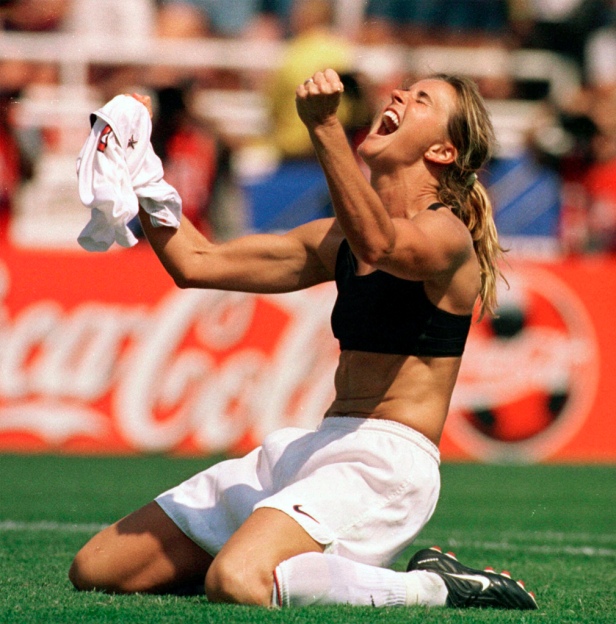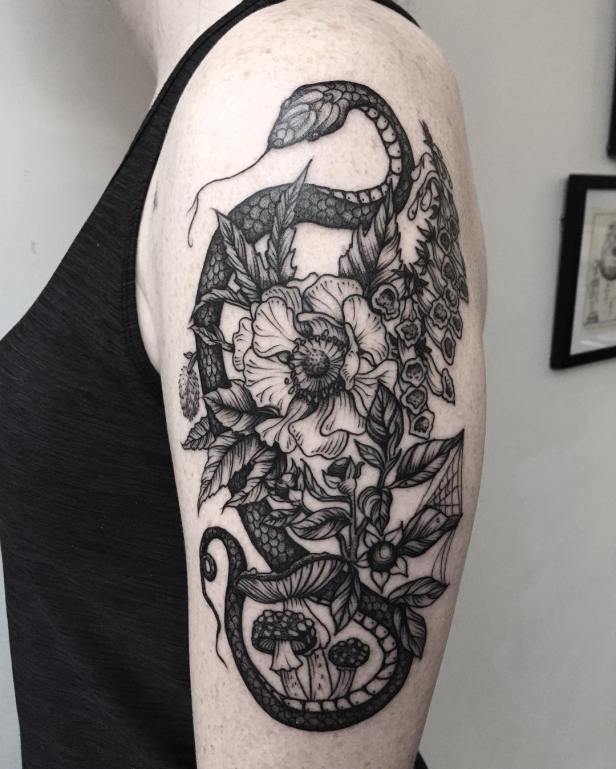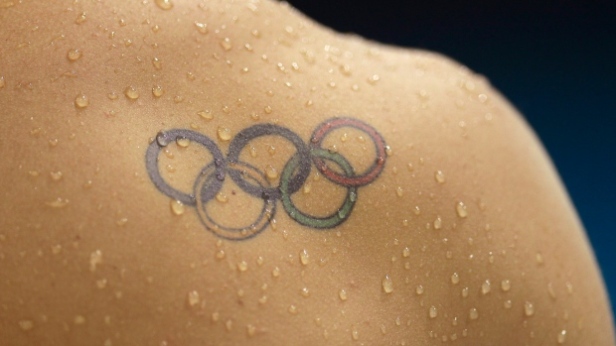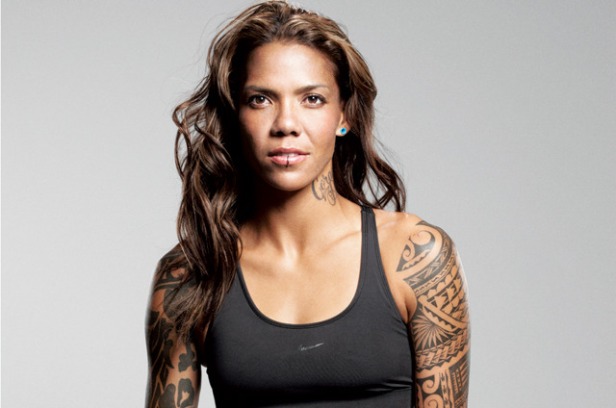Your Mom hates them, your friends think you’re the coolest for having them, and everyone around you seems to think that you’ll regret them in a certain number of years. They’re the thing that make you, you, and they help make you feel comfortable with who you are- they’re your tattoos. Tattoos have a long and interesting history in Western Society, they’re inception into the mainstream only coming about around the late 20th Century. What seems more interesting however, is their rapid rise in popularity in sports. Now a days, tattoos are everywhere in sports (well more like sorta everywhere), their art adorning many popular male athletes such as David Beckham and Lebron James; however, what seems to be non-existent is body art on female athletes. Yes, tattoos do exist on a small portion female athletes, and they are some of the most noticeable personalities within the female sporting community. They also happen to be the most ostracized. So the questions that I want asked, and will answer, are”Why are there not more tattoos on women in sports?” and “What purpose do tattoos serve for those who do adorn them?” These questions themselves first require a base level of understanding towards the female athletic body, especially when juxtaposed against the rigid societal pressures women already face towards the way they look.
The Fe(male) Athletic Body

“She looks like a man.”
The cliche line that seems to circulate around high school boys and locker rooms with regard to athletic looking girls. This observation, while trivial to boys, is a huge source of contention and insecurity around women, and the bodies they must possess to be competitive in sports. As Vikki Krane et al (2004) denote,”Ideally, sportswomen have toned bodies, yet they also mus avoid excessive masculine-perceived, muscular bodies” (317). To be muscular is equivocal to being masculine, and thus women must struggle to maintain strength, but not their muscularity gained from performing in their sports. This paradox of the body is a direct of society norms placed on women regarding their appearance.
Additionally, within women’s athletics, many women regard their bodies as a dichotomy: there is the athletic body, and there is the female body. At any given time, both cannot be present. In fact, many women attempt to distance themselves from their athletic body while in non-athletic situations. As Molly George (2005) suggests,
“Negotiating a relationship between these two selves can be understood as a task where a woman athlete literally and figuratively embodies two physiques, the performance body and the appearance body” (326).
It’s in these negotiations that female athletes are asked to be able to stay physically competitive, but also conventionally attractive- often times the muscle mass they acquire is too much for what society has deemed acceptable, causing these athletes to become incredibly insecure about their appearance.
Conversely, this new body many women acquire is empowering. The strength that athletics provides an individual is always empowering, and it’s the same for women. What is important to take away from this dichotomy however is that women are still being marginalized for how they appear. Even when THEY feel empowered, there are still pressures and gazes towards them that make them feel insecure and, “Teammates [use] these [unfeminine] characteristics to put down their opponent” (George, 327). Borrowing Micheal Foucault’s idea of the bio-citizen, women are policing other women to adhere to society’s understanding of femininity and beauty, even though they all require the same strength to compete, and any deviance from the matter is unacceptable. So while being empowered is cool and all, being unfeminine is unthinkable.
Tattoos and You
Now, let’s talk about tattoos. What do tattoos do? It is believed that tattoos are obtained for a multitude of reasons, however those reasons remain grounded in the principle of the individual expressing their agency upon themselves. As most are quick to point out, tattoos are permanent. This underlying characteristic of tattoos makes them one of the highest forms of self agency an individual can enact. As Mary Koust (2000) denotes,
“Tattoo narratives are spoken through a body that has been physically altered, a body that must come to terms with its new physicality” (98).
Tattooing ones body is the ultimate act of transformation and reclamation. Flexing agency to control your body through the tattoo that you get that you choose is how you are able to take back control of the body you live in. In coming to terms with this body, the wearer then becomes more capable of understanding and accepting oneself, as they are the literal product of their own creation.


While the act of getting tattoo is an important part of the work that tattoos do on shaping the self, the actual tattoo also has an important role to play in the narrative on shaping self identity. Mary Koust (2000) further points out how tattoos are thought to be reflections of the self. Often times the wearers will chose iconography that reflects how they feel at the time of their session, or just images that express who they feel they are. This is where that whole “You’ll regret this later” phrase caught on, as people change but tattoos are permanent. The changing narratives of people is also accounted for in their tattoos. The permanency of tattoos is believed to act also as a reminder; a reminder of who someone used to be, and in this sense tattoos help to shape self reflexive tendencies (Koust, 2000).
That’s it, that’s why people get tattoos, or better what tattoos do for people. Instead of asking why people get tattoos, we should look at what tattoos do for people. If we use this framework/ state of mind, we can also begin to understand why female athletes don’t have tattoos, but also what they can do for women athletes.
Why don’t Athletes have Tattoos in General?
Okay, so again, before we talk about female athletes and tattoos we first have to talk about the intersection of sports and body art. It’s this weird place where it seems that only athletes that compete in team sports are socially allowed to adorn body art, not athletes who compete in individual sports. Unless you’re in the Olympics. Then it’s all okay, as the Olympics denote the highest level of competition for individual athletics (the cultural capital of tattoos and the Olympics is a subject for another time). Just watch this video of Canada’s Summer Olympic team talk about their tattoos and look at what I mean. It’s weird, everywhere else in individual sports tattoos are frowned upon; as they reflect beauty ideals counter to the normative standards of the West as tattoos are based from Native cultures, or are traditionally worn by criminals or societal deviants (Hardin, M. 1999).

The social deviance that is attributed to tattoos has played a huge contribution for their exclusion from most individual sports. Individual sports like swimming have a history of being only for the elites. This elitist perspective on sports has transferred over to the agency given to the athletes and their bodies- bodies that are not allowed to be attributed with the discrepancies of society. Furthermore, race has played a role in the exclusion of tattoos. Again reacting to the traditions of individual sports, athletes are ill received for adorning body art in these fields because of the nature of their sport (for swimming its pools only for white people), and the nature of tattoos. Understanding the reservations on the sporting community’s reluctance to accept tattoos, and the connotations that they derive will help to illuminate the lack of female tattoos, and why the athletes are ostracized.
Question 1: Why don’t Female Athletes have Ink?
Let’s just get it out of the way- the main reason women in sports don’t have tattoos is because they’re too masculine. It’s reductionist to think this way, but its the truth. Well sorta, there’s also this whole issue of homophobia in women’s athletics. We’ll tackle the issue of masculinity first, as homophobia builds off of this idea of the hyper-masculine.
As already discussed, women face a huge crisis of the self when confronted with bodies that they acquire through sports. These bodies, just in their nature and stature, challenge the notion of what is feminine strictly because they’re muscular out of necessity. Visible tattoos have long had connotations associated with masculinity. Mixing the ideas of visible tattoos (say the arms or legs) is just too much for society to handle. The coalescing of these two forms of masculinity creates a hyper masculine entity; however on the female body it creates a paradox. This paradox, “[Conflicts] with the traditional, demure, and passive gender role expected of women in Western society” (Mun et al, 2012, 137) or challenging of gender norms as I prefer, is what deters women away from obtaining body art. Not only does society tell them that they cannot be masculine, but they are also already telling it to one another. The sports world is ‘othering’ women, or separating them from society because of their bodies. This is where the whole homophobia thing comes in, as it is a direct product of societies fear of the gender paradox.

“In sports, all women are considered to be homosexual unless proven otherwise” should be one of the things that women are told as children when they start to consider entering competitive sports. This isn’t actually the case, as women who can perform femininity and their gender are excluded from this stigma. However, women who can’t face rumors of homosexuality and must actively prove how they’re not gay. This is where tattoos and the hyper-masculine female body intersect with homosexuality. Tattoos on women add to their already perceived masculine bodies, and with the failure of feminine performance comes accusations of homosexuality. As Smantaha King (2009) observes about the WNBA,
“Homophobia was without exception universalized, so that discussions of how homophobi and racism work in concert with one another to shape the experience of players and fans were absent” (280).
Society cannot handle an army (lets face it, women in sports could be an army) of women who ‘look’ like men and have tattoos like men, so instead they ostracize and belittle them in hopes of deterring any deviancy from the norms. This reaction to masculinity is one of the main reasons that women don’t sport tattoos in athletics.
Question 2: Why do we Care?
It’s a seriously good question. Why does women not having tattoos in sports mean anything? It’s actually tied into the notion of what a tattoos do for people. The self expression that we talked about early extends to women in sports. It allows them to have a place to contend their identities with. The musculature gained is the byproduct of pursuit of athletic excellency; it is something that gets critiqued for merely existing as a means to an end. Tattoos are different, they are a choice. Tattoos allow women and athletes to contend with their body in spaces not originally designed for rebellion. Tattoos self-expressive, and reflexive, nature empower women to love their bodies, even if they are not what is considered standard. They allow women to show the world their identity underneath their physicality by enabling women to choose how they represent themselves. As Emmons and Billings (2015) enlighten,
“Tattooing as an act of resistance of body is one way to rebel against the hegemonice presures, an act of passive physical resistance in the owning of one’s body and visual resistance” (71).
Additionally, tattoos can also be used to help forward social movements in women’s sports, or at least break traditionally gendered perceptions of women athletes.
Women like Natasha Kai are tattooed and successful. They have reached the highest summit of their sporting world, and have come back with a win. They also help to destroy gendered notions of what it means to be a female athlete. Natasha is an individual who has an athletic build, much like the other female athletes, which is required for her to be successful in her sport. She is also, and by all accounts that I’m aware of, covered in tattoos. Her body is in direct opposition to the normative standards of beauty- and that’s why tattoos in female sports are important. Her body is the physical manifestation for the rebellion against the patriarchal ruling over the female body and their appearances. Her body helps to illuminate the ‘othering’ that is occurring women’s sports which, “continues to influence not only issues such as participation and retention but also how governing bodies draft policies, rules, and regulations” (Couture, J. 2016. 128). This simple act can go an immense way in reshaping the existing practices in place around sports leagues not only towards women’s beauty standards, but also homophobia. She also came out as gay over an NBC broadcast during the 2008 Beijing Olympic games, linking gayness with her appearance, but in accepting who she is, is it really a bad thing to be gay?

Just Some Last Thoughts
It’s easy to see why women are discouraged from getting tattoos during their athletic careers. The humiliation and stigmatization they face from their communities is immense and could ruin their career. However, while it is difficult to see the positive aspects of tattoos on women in sports, they are there. Women like Natasha Kai are leading the way in redefining what it means to have a female body in sport, challenging gender norms and changing the way people think about high level tattooed women in general. Tattoos are also empowerment, where society continues to demonize women for having muscle and makes them self conscious about they body they earn, tattoos can liberate some of that burden; empowering women with the ability to express their identities more openly on and off the field/court.
References
Calhoun, D. (2006, Oct). Kai takes advantage of Opportunity. The Orange County Register.
Couture, J. (2016). Triathlon Magazine Canada and the (Re-)Construction of Female Sporting Bodies. Sociology of Sport Journal, 33, 124-234.
Crouse, K. (2012, July 24). U.S. Swimmers Go for Gold, and a Tattoo. The New York Times, p. B10.
Dececco, J., Atkins, D. (1998). Looking Queer: Body Image and Identity in Lesbian, Bisexual, Gay, and Transgender Communities. Retrieved from http://books.google.com/books
Fagan, K. (2015, Jun). Brittney Griner opens up and bares all. ESPN. Retrieved from http://www.espn.com
George, M. (2005). Making Sense of Muscle: The Body Experiences of Collegiate Women Athletes. Sociological Inquiry, 75(3), 317-345.
Hardin, M. (1999). Mar(k)ing the Objected Body: A Reading of Contemporary Female Tattooing. Fashion Theory, 3(1), 81-108.
King, S. (2009). Homonormativity and the Politics of Race: Reading Sheryl Swoopes. Journal of Lesbian Studies, 13(3), 272-290.
Koust, M. (2000). Tattoo Narratives: The intersection of the body, self-identity and society. Visual Sociology, 15(1), 79-100.
Krane, V., Choi, P.Y.L., Baird, S.M., et al. (2004). Living the Paradox: Female Athletes Negotiate Femininity and Muscularity. Sex Roles, 50(5), 315-329.
Mun, J., Janigo, K., Johnson, K. (2012). Tattoo and the Self. Clothing and Textiles Research Journal, 30(2), 134-148.
Natasha Kai. (2009, July). Advocate.
Szto, C. (2016). Race/Ethnicity. Week 8 Lecture.
Szto, C. (2016). Sport, Consumption and Citizenship in a Neoliberal Era. Week 4 Lecture.
Watson, J. (1998). ‘Why Did You Put That There?’: Gender, Materialism and Tattoo Consumption. Advances in Consumer Research, 25, 453-460.

